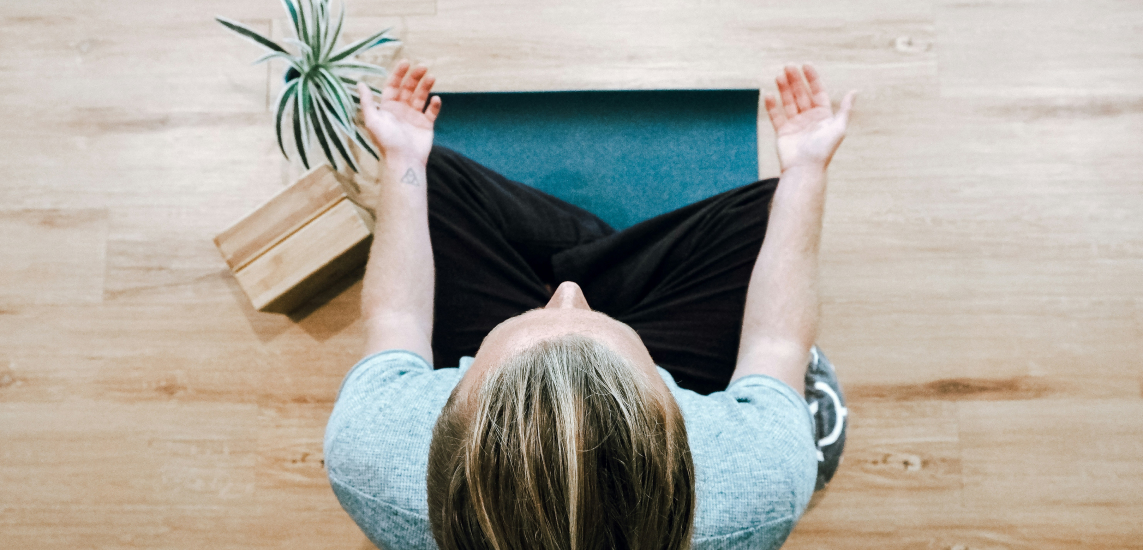Negativity bias affects nearly everyone whether we’re conscious of it or not. It is the mental pattern of focusing on the negative over the positive; to look at a crystal-clear sky and find the tiniest grey rain cloud.
This mental process has a powerful biological link based on millions of years of evolution. However, its detrimental effects on our body, mind, and psychology outweigh the positives. Thankfully, anyone can learn to counteract negativity bias with meditation and simple practices for everyday life.
What Is Negativity Bias?
Have you ever asked a friend how they liked their vacation and they replied with a sigh, “Well, the beach was beautiful, the food was delicious, and I relaxed like I haven’t in years, but our flight was 30 minutes late and absolutely ruined everything”?
That’s negativity bias.
It is the brain’s hard-wired habit of remembering the bad of an experience over the good. It’s rooted in millions of years of evolution in which hazards represented a life-or-death situation that could wipe out a species for good.
Leading negativity bias researcher Rick Hanson, PhD puts it this way,
“In the tough environments where our ancestors lived – if they missed a carrot, they usually had a shot at another one later on. But if they failed to avoid a [hazard] – WHAM, no more chances to pass on their genes.”
Millions of years of psychological conditioning have made our brains into Velcro for negative experiences and Teflon for positive ones. This wouldn’t be so bad if our environments were as chaotic and dangerous as they used to be. Unfortunately, for those who live in affluent developed societies, negativity bias has wide-reaching implications for psychological and mental health.
The Wide-Reaching Effects Of Negativity Bias
Negativity bias has a direct impact on relationships, popular culture, and lifestyle. It’s the reason why those who can overcome their negativity are not only happier people, but more successful, too.
Relationships
Researchers have found that it takes five positive interactions between spouses to outweigh a single negative interaction. This “negative over-learning” can be a death toll for struggling marriages. The same concept applies to friendships and relationships between colleagues.
On the other hand, friends and family who argue constantly will stick together when there’s a healthy 5-to-1 ratio of positive & loving interactions between negative ones.
Popular Culture
In popular culture, political messages are a classic example of marketing that capitalizes on negativity bias. Surveys show that voters dislike negative ads. Research, however, shows that our brains love them. Political ads are often negative because negativity is memorable; negative ideas “stick” long after we’ve forgotten who sponsored it.
Lifestyle
Finally, a negativity bias can drag down our ability to live the life of our dreams. Researchers have shown that negativity correlates to an increase in the hormone cortisol, causing us to be stressed-out and decreasing the effectiveness of our immune system over time. This has a wide-reaching impact on our ability to be present in our relationships, at work, and at home.
Not only do we get and stay sick, but we also earn less money. In a study by Psychologist Susan Segerstrom, law students with an optimistic outlook earned $32,667 more than their glass-half-empty peers. Positivity pays!
Overcoming Negativity Bias With Neuroplasticity
For most people in developed, affluent societies, negativity bias is no longer a survival mechanism – it’s a handicap.
Fortunately, our brain’s innate neuroplasticity makes it possible for us to rewire ourselves towards the good when we become attuned to positive emotions over negative ones.
Tilting our minds towards the good
- puts challenges in perspective,
- lifts spirits, and
- get things done.
This results in healthier, happier, richer lives & relationships.
Daily Exercises To Overcome Negativity Bias
The first step is noticing how and why you become negative, then re-training the brain.
Training your amygdala to notice positive moments over negative ones involves both interrupting our negative patterns when they start, plus embedding positive focal points. Over time, the brain will begin to catch itself naturally when it starts to spiral. The positive focus will keep you on the up-and-up to focus on happiness overall.
Noticing Negative Patterns…
…With Self-Study
The first step to re-training the brain with daily life practices is to notice the triggers that set you into a negative spiral.
Here are real-life examples:
- Take note if you notice yourself mentally reviewing a negative conversation and becoming anxious, angry, or upset.
- Notice the negativity you feel when your spouse, partner, or family member does that annoying behavior that starts you down a spiral of anger.
- Observe your inner critic when it starts to bring you down with negative phrases like, “You’re an idiot,” or “You’re not smart enough.”
Ask yourself what started you down that path. Perhaps you were tired, hungry, lonely, or embarrassed.
Begin to make a list of the “trigger” moments in your life. You’ll begin to notice patterns in how your body feels immediately before a negative episode.
Remember, your brain evolved to survive, and noticing negative events was a critical part of human survival for generations. There’s no shame in a tiny event making you unnecessarily upset.
This self-study leads to the ability to create pattern interruptions that tilt you, your body and your brain towards positivity.
…With Mindfulness & Learning To Accept Emotions
Mindfulness is a well-researched method that can help overcome negativity bias by re-training the brain to focus on positive experience over negative.
This practice is a mechanism that can reduce emotional distress by allowing us to step back from negative thoughts and feelings.
Researchers at the Greater Good Science Center at the University of California, Berkely, explain that mindfulness helps us break free from negativity because it has two core components that help us step back from our thoughts and feelings:
- Maintaining an undivided awareness of our thoughts and feelings
- Accepting these thoughts and feelings without judgment
Approaching our thoughts and feelings without judgment allows us to compassionately watch them rather than getting caught in a whirlwind of negativity.
Imagine… What would happen if you could simply notice that you are anxious and allow yourself to feel the anxiety within your body without getting sucked in for hours? Mindfulness training develops these skills over time.
Start practicing mindfulness now with the help of these guided mindfulness meditation practices by popular meditation teachers:
- Quiet and Connected - Mindfulness Meditation Joseph Goldstein 11:40
- Gateway To Presence Tara Brach 10:31
- Mindfulness Meditation Ram Dass 18:13
- Mindfulness Meditation Hugh Byrne 15:05
- Mindful Awareness Meditation Kate James 9:39
- A Few Minutes of Mindfulness Melli O'Brien 6:40
- Mindfulness Now Joshua Canter 14:29
- Mindfulness Of Body And Breath Mark Williams 8:09
Mindfulness Techniques To Overcome Negativity Bias
The practice of mindfulness can involve investing in a teacher or simply embedding new habits into your daily life.
If you are new to mindfulness, try one of these five simple mindfulness exercises that build brain-strengthening positive habits over time from Harvard Graduate School of Education lecturer Metta McGarvey:
- Several times a day, take a break from whatever you’re doing to reset and focus on a feeling of calm.
- Practice looking for small moments of beauty or kindness. Observe them multiple times a day.
- Comment on the positive qualities & actions of other people.
- Make exercise a habit, for example, yoga, running, meditation, dancing, and tai chi, to release stress and evoke a physical relaxed state.
- Be patient with yourself with developing new habits. Focus on the small positive steps you make.
Read more: Habit change expert Hugh Byrne explains how habitual behavior forms and mindfulness is a key of breaking bad habits.
Creating Pattern Interrupts That Generate Positivity
The next step is to embed pattern interruptions to shift your energy when a trigger becomes active:
- When your body feels anxious, upset, or stuck, activate your muscles and shift your focus with exercise, walking, moving or cleaning. Moving the body can productively engage the mind; plus, endorphins reduce pain and boost pleasure in the brain. Moving, stretching, and strengthening the body can release stored tension, too.
- Next, begin to train the mind towards positive pattern interruptions. A first step is to substitute negative self-talk with positive self-talk. When you catch your inner voice saying something like, “You made a huge mistake, stupid!” change the frame to an objective and generous viewpoint. Telling yourself, “I could have done this better, and I will next time. This time ended up working out well, and I’m happy about that.”
- Finally, begin to approach your inner critic with kindness and compassion as you would a friend. This inner critic came to you as a real survival mechanism, whether from childhood or millions of years of evolution. It has a valuable role in saving your skin when real danger strikes. Respond to its “You’re worthless!” with softness. Ask yourself, “Are you OK? Why are you upset? Did something happen?” Allowing yourself to question your inner critic can reveal wisdom about your inner state. Fostering a warm and gentle dialogue with the negative inner voice creates a healthier relationship with the self in the long-term.
Metta Meditation To Increase Positive Emotions In The Body & Mind
The first meditation practice that improves our positive outlook is Metta, or loving-kindness meditation. This ancient Buddhist practice guides the practitioner to choose a positive sentiment or phrase, such as “May I be happy,” then focus on this phrase as the “object” of concentration.
Other stages of the meditation may include directing the same emotion towards others, like a friend or family member, then expanding the aperture to include the community and even the world.
Often, practitioners experience a tremendous opening of the heart, the development of equanimity, and the nurturing of empathy and compassion for others, just by focusing on a positive phrase.
In a 2010 study, researchers demonstrated that metta may generate enough positive emotions to counter negative emotional processes implicated in disorders like depression, anxiety, and schizophrenia.
Buddhist publication Buddha Weekly published a summary of peer-reviewed materials showing that metta has demonstrated dozens of potential benefits for psychological and physical health. It is worth noting that most of the studies in this article require corroboration.
Overall, metta is an excellent tool in overcoming negativity bias, and it’s simple enough to begin working on at home.
Practice meta with these guided loving-kindness meditations:
- Five-Minute Lovingkindness Meditation Bodhipaksa 5:30
- Loving This Life - Happiness (Metta Meditation) Tara Brach 16:30
- Lovingkindness Meditation Sharon Salzberg 15:04
- 10 Minute Metta for Goodwill & Loving-Kindness Mark Zelinsky 10:52
Start The Day With Positive Affirmations
Setting a positive tone for your day goes a long way towards a positive outlook in life. Positive affirmations can go a long way to keeping you optimistic and grounded.
Read more: Discover what makes a healthy morning routine healthy and how to reduce anxious feelings in the morning.
A positive affirmation is a phrase that creates a positive emotion in your body and mind. They can be any length. Create a short list of phrases and practice saying them in the mirror every day.
For example, if you are struggling with money, a positive affirmation for money could be, “I love money because it comes to me easily. I wake up every day knowing money is guaranteed for me.”
Positive affirmations help to re-train the brain by teaching us to expect the positive outcome or outlook. Eventually, you’ll find your brain naturally substitutes, “I always have money,” when it’s time to pay bills, so you focus on how much money you do have rather than being scared of not having enough.
Explore hundreds of free guided affirmation meditation practice to manifests goals or changes in behavior.
Daily Gratitude List
A personal favorite of mine is a gratitude list. It’s a simple way to focus on what you love about your life so that you see more of that and less of the negative.
Add a short gratitude list to your morning or evening routine. Write in your journal 5 – 7 people, places, or events for which you are grateful with a sentence or two on why you’re grateful.
In addition to the positive effects of a gratitude list in the moment you write it, they also provide a wonderful way to look back on past events. Reading old gratitude lists basically re-writes the brain’s inherent negative memories into positive ones.
Improve your greater emotional well-being and physical health with the help of these guided gratitude meditation practices.
Surround Yourself With Positive People
Your environment influences how you feel. A crew of positive family members, friends, or colleagues will go a long way to keeping you positive in the long term.
Surrounding yourself with people who believe in you and see the world with an optimistic outlook will shift your worldview towards positivity. You’ll contribute to their growth with your positivity, too.
Overcoming Negativity Bias: Getting Started
Overcoming negativity bias starts with realizing that it’s normal to feel this way and it has a biological reason. That said, negativity can be a handicap in today’s society that keeps you mentally unhealthy & drags down your possibilities for a bright future. Start with self-study through meditation and self-observation and add simple practices into your life to shift your brain towards a positive future.
Read more: Negativity is also dominant when it comes to body image. Psychotherapist Andrea Wachter proposes six ways that we can turn this negative body image epidemic around.


-1.jpg)




